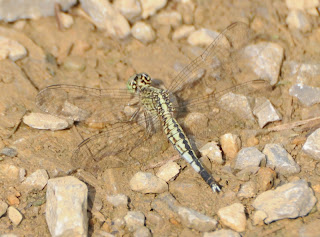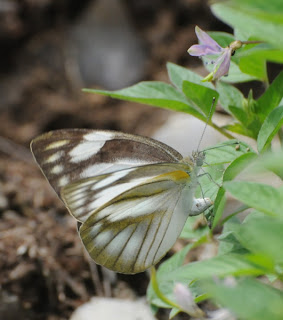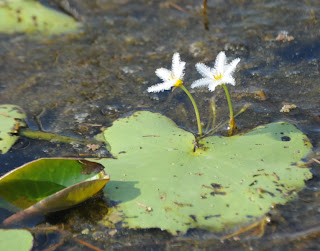At Chupak, the villagers were tending the last of their harvest. Much of the rice had already been cut back - usefully for birders who want to see what might be stalking around the base of the plants. Some, though, was still awaiting harvest, and we arrived not just at a good birding time but in the midst - as you shall see - of a war between the rice farmers and the birds that also wanted a share of their crop.
Water birds, though, are no competition for rice growers, and I am sure the owner of this house would have no objection to the Little Egret (Egretta garzetta) standing guard in front of it.
Chupak is becoming a particularly good place for rails. We saw five species altogether, including Common Moorhens (Gallinula chloropus) and several family groups of the ubiquitous White-breasted Waterhen (Amaurornis phoenicurus). The Buff-banded Rail (Gallirallus philippensis), only last year a remarkable rarity at Chupak, now seems to be breeding. I saw at least three, and Vincent found a family with chicks.
White-browed Crakes (Porzana cinerea) seem to be common. This bird was perching atop a bush in most un-rail-like fashion.
This photo, though not particularly good, shows this species' very long toes; like the even longer-toed jacanas (Jacanidae), White-browed Crakes are adept at walking on floating vegetation.
Our fifth species was a single bird foraging quite openly in roadside vegetation (very close, in fact, to the house in the egret photograph above - as in fact were all five of the rails we saw).
It was, to my astonishment, a Ruddy-breasted Crake (Porzana fusca), supposedly a rare bird in Malaysia (though with birds as elusive as crakes, the rarity may be more apparent than real). Anyway, it was a lifer for me.
I brought Vincent back from his family of Buff-banded Rails, but though the bird called a few times in response to a tape we did not see it again.
While looking for birds, of course, we came across other creatures, including this colourful little Green Paddy Frog (Hylarana erythraea).
As always, there were plenty of dragonflies in attendance along the edge of the paddies. Ictinigomphus decoratus is common enough, but it is large, striking and never fails to get my attention.
The female Diplacodes trivialis (above) looks very much like the more abundant Orthetrum sabina (which, for once, I am not including in this posting), but is smaller, with a shorter abdomen. The powder-blue male (below) is unmistakable.
Rhodothemis rufa is one of a number of similar red dragonflies; one clue to its identity are its eyes, which only just touch over the top of its head.
Another red dragonfly (and a very common one) is Orthetrum testaceum. It is very similar to another common species, O. chrysis; C. Y. Choong gives a nice run-down of the differences, which include a paler, more reddish-brown thorax in O. testaceum.
This photo records my first encounter with Acisoma panorpoides, a small dragonfly with a unique bottle-shaped abdomen. This is a female; the male, like the male Diplacodes, is largely blue.
Rhyothemis phyllis is one of the more elegant and striking of Borneo's dragonflies, and certainly one of the easiest to identify.
Here are a couple of other insects: a handsome bug that I would love to identify...[update! It's a tortoise beetle, a member of the family Cassinidae]
... and a common butterfly, the Striped Albatross (Appias libythea). This is a female.
Faithful readers of this blog may remember the Buckbean I wrote about recently in my account of the Bog Trail in Cape Breton, Nova Scotia, a member of the small aquatic plant family Menyanthaceae. This is one of its tropical cousins: the Water Snowflake (Nymphoides indica).
The ripening of the rice brought in hordes of munias, mostly Chestnut Munias (Lonchura atricapilla) - a delight to us but a menace to the struggling villagers, who did everything in their power to keep the birds from falling on their crops. This included shaking flags strung out on lines across the paddies, banging pots, and ringing bells - a full-time, wearying and no doubt dispiriting job.
It also included surrounding and covering the paddies with mist nets - not just a way of keeping the birds from the seed heads, but as a fatal trap.
Mist nets are designed not to reject, but to entangle. Birds diving for the crops, caught by a wing, head or leg, cannot get free, and soon die. We found many nets dotted with their bodies.
Birds are not the only things the nets catch; here, an entangled dragonfly - perhaps an Ictinigomphus - provides a bounty for a more fortunate wasp.
It's hard to blame the struggling farmers, uncomfortable as scenes like these may be to western birders. We can ask, though, if this is the best way to reduce the damage ricebirds undoubtedly cause. In Africa, studies have found that Red-billed Queleas (Quelea quelea), a serious crop pest, are first attracted to the fields by weed growth, and keeping down the weeds reduces the attacks. Would this work in Asia, where munias are less nomadic than Queleas and may stay in the area year-round?

































No comments:
Post a Comment